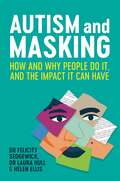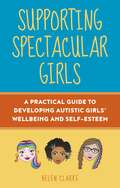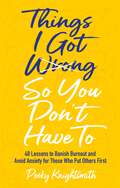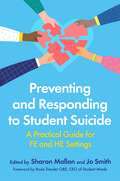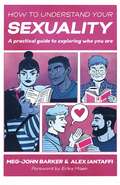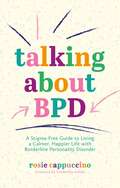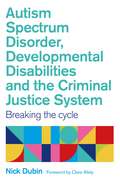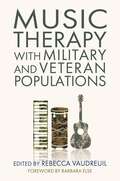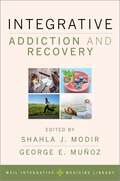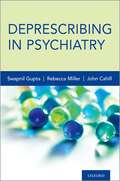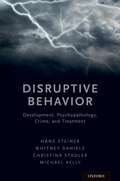- Table View
- List View
Art Therapy with Veterans
by Erin Partridge Gioia Chilton Deborah Murphy Jashley Boatwright Kevin D’Augustine Courtney Bennett Raquel Farrell-Kirk Peter Buotte Meredith McMackinWith both personal and professional insight from a range of contributors, this informative guide highlights the use of art therapy in a range of settings to support military veterans. Offering a wealth of knowledge on this approach and the variety of current programs available, this is an invaluable resource for all therapists looking to provide support for this population.Chapters explore the use of art therapy in a range of different settings, including museum programs, open studio therapy and assisted living environments, as well as large group therapy at treatment facilities for active-duty service members. It also offers rare insight into the effectiveness of art therapy in supporting veterans who are processing military sexual trauma, moral injury and countertransference, filling essential gaps in knowledge within this area.As demand for this practice continues to grow, Art Therapy with Veterans provides inspiration for future programs and therapists looking to support military communities.
Autism and Masking: How and Why People Do It, and the Impact It Can Have
by Helen Ellis Felicity Sedgewick Laura HullAutistic people often feel they have to present as neurotypical or perform neurotypical social behaviours in order to fit in. So-called 'masking' is a social survival strategy used by autistic people in situations where neurodiversity is not understood or welcomed. While this is a commonly observed phenomenon in the autistic community, the complexities of masking are still not widely understood.This book combines the latest research with personal case studies detailing autistic experiences of masking. It explains what masking is and the various strategies used to mask in social situations. The research also delves into the psychology behind masking and the specifics of masking at school, at social events with peers, and at work. The book looks at the consequences of masking, including the toll it can have on mental and physical health, and suggests guidance for family, professionals, and employers to ameliorate negative effects. With a diverse range of voices, including perspectives across gender, ethnicity and age, this is the comprehensive guide to masking and how to support autistic people who mask.
Supporting Spectacular Girls: A Practical Guide to Developing Autistic Girls' Wellbeing and Self-Esteem
by Helen ClarkeAutistic girls can be frequently misunderstood, underestimated and therefore anxious in a school environment. This practical book offers an innovative life skills curriculum for autistic girls aged 11 to 15, based on the author's successful workshops and training, which show how to support girls' wellbeing and boost their self-esteem.Including an adapted PSHE curriculum, this is a straightforward guide to educating autistic children on the issues that matter most to them. It covers all essential areas of wellbeing, including communication, identity, self-regulation and triggers, safety, and physical and mental health, and offers the reader strategies to help the autistic girls in their lives enhance and develop these.
Things I Got Wrong So You Don't Have To: 48 Lessons to Banish Burnout and Avoid Anxiety for Those Who Put Others First
by Pooky KnightsmithAn internationally respected campaigner, Pooky Knightsmith has worked tirelessly to promote good child and adolescent mental health. Her knowledge, ideas and advice come not just from years of research and study, but from hard earned experience with PTSD, anorexia, self-harm and depression.Part mental health guide, part memoir, this book contains 48 life lessons learned from everyday victories to life-changing events. Pooky shares tips on how to avoid burnout, how small acts of self-care can make a big difference, steps you can take to live with anxiety, and how to nurture key friendships and relationships, amongst many other things. Each lesson ends with space for the reader to reflect, and includes exercises to help take the first steps to incorporating these lessons into their own lives.Unflinching and utterly authentic, Pooky shares the things she got wrong so that you don't have to.
Art Therapy in Response to Natural Disasters, Mass Violence, and Crises
by Cynthia Wilson Gaelynn P. Bordonaro Eduardo Torres Maria Regina Alfonso Ronald Lay Raquel Farrell-Kirk Amanda Sanders Maria Rollins Jill Charney Elia Khalaf Alicia Ballestas Devora Weinapple Jess Linton Geri Hurlbut Daniela Gloger Katrina Bobo Robin Valicenti Carla Van Laar Dr Maricel Ocasio-Figueroa Anais Lugo Axtmann Stephanie Wray Mercedes B. ter Maat Soraya Obeid Natacha Pirotte Laurence De Vandenborre Dianne Tennyson Vincent Barbara Naderi Leigh Ann Lichty Jessica Asch Lisa Tricomi Bree Gordon Kelvin A. Ramirez Mitchell Kossak Joseph Mageary Maria Johanna Ortiz-LuisWith contributions from a range of expert voices within the field, this book explores the use of art therapy as a response to traumatic events. Offering rare insight into ways in which art therapists have responded to recent crises, this is a unique resource for art therapists looking to coordinate interventions for large-scale disaster and resulting trauma. Chapters address a range of environmental and manmade disasters around the world, including hurricanes, typhoons, wildfires, mass shootings and forced migration, highlighting the impact of an art therapy approach in dealing with widespread trauma. Covering both community and individual cases, it provides an in-depth view into the challenges of working in these settings, including the effects on the therapist themselves, and offers practical information on how to coordinate, fund and maintain responses in these environments. The first book to focus on disaster response in art therapy, this will be an invaluable contribution to the field in an increasingly vital area.
Preventing and Responding to Student Suicide: A Practical Guide for FE and HE Settings
by Various AuthorsThis practical book covers issues related to suicide risk, prevention and postvention in Higher and Further Education communities. Compiled by 37 experts, it is an authoritative guide to an issue that is causing increasingly large concern for FE and HE institutions and covers multiple evidence-backed approaches with a pragmatic focus. It is the first that specifically deals with student suicide in FE Colleges and universities, encouraging a holistic, institutional response. Chapters are split into three sections, beginning with understanding and preventing student suicide among students, followed by responses to risk, including a model for student prevention in HE settings. The book concludes with the response to student death by suicide with advice on postvention, and how to support bereaved family, staff, and students.
Life on Autopilot: A Guide to Living with Depersonalization Disorder
by Joe PerkinsCombining personal experience with professional advice, this book offers a much-needed insight into living with DPD. It explores the science behind the disorder and the effect that it has on everyday life, offering practical advice and coping strategies for those living with it.
How to Understand Your Sexuality: A Practical Guide for Exploring Who You Are
by Alex Iantaffi Meg-John Barker'A goldmine of wisdom' CYNDI DARNELL'Gentle, kind and embracing' JUNO ROCHE'Interesting and engaging' JUSTIN HANCOCKGay, straight, queer, pansexual, demisexual, ace...? Sexuality is complex and diverse, but it doesn't have to be confusing.This down-to-earth guide is the ultimate companion for understanding, accepting and celebrating your sexuality. Written by two internationally renowned authors and therapists, the book explains how sexuality works in terms of our identities, attractions, desires and practices, and explores how it intersects with our personal experiences and the world around us.With activities and reflection points throughout, it offers space to tune into yourself and think deeply about your own sexuality. You'll hear from people across the sexuality spectrum and in different relationship set-ups, and be inspired by the ideas of scholars, activists and practitioners. Sexuality is a vast and wonderful landscape - let this book guide you on your journey!
Talking About BPD: A Stigma-Free Guide to Living a Calmer, Happier Life with Borderline Personality Disorder
by Rosie CappuccinoDrawing on the author's lived experience, this hopeful guide offers advice on everyday life with BPD. Covering what BPD is, how to talk about it, and how to get support, it includes practical coping tips and DBT-based techniques, while also tackling the stigma and negative stereotypes associated with the disorder.
Designing Mind-Friendly Environments: Architecture and Design for Everyone
by Steve MaslinExploring the impact of the built environment and design on people with a range of neurological experiences, including autism, dementia, dyslexia and dyspraxia, this comprehensive guide shows how modifications to architecture and interior spaces can positively benefit the lives of everyone and advises on how to create and design 'mind friendly' environments.
The Simple Guide to Collective Trauma: What It Is, How It Affects Us and How to Help (Simple Guides)
by Betsy de Thierry· What is collective trauma?· How can it impact children and communities?· What can we do about it?Providing accessible answers to these complex questions and more, this guide explores the key characteristics of collective trauma and provides practical advice on how to help children, young people and communities to heal.Collective trauma affects communities, families and individuals. This book highlights its impacts and with examples such as grief and loss, outlines how it can manifest. With guidance on building individual, communal and cultural resilience, this book is an invaluable resource to better understand and support children and young people dealing with collective trauma.
Turn the Tide on Climate Anxiety: Sustainable Action for Your Mental Health and the Planet
by Megan Kennedy-Woodard Dr. Patrick Kennedy-WilliamsIt's hard to watch the news, scroll through social media, or listen to the radio without hearing or seeing something disturbing about the climate emergency. This can trigger all sorts of emotions: worry, anger, sadness, guilt, and even grief but also often over-looked positive emotions like motivation, connection, care, and abundance that support mental health and climate action for sustainable longevity.Written by psychologists with extensive experience in treating people with eco-anxiety, this book shows you how to harness these emotions, validate them, and transform them into positive action. It enables you to assess and understand your psychological responses to the climate crisis and move away from unhealthy defence mechanisms, such as denial and avoidance.Ultimately, it shows that the solution to both climate anxiety and the climate crisis is the same - action that is sustainable for you and for the planet - and empowers you to take steps towards this.
Superhero Therapy for Anxiety and Trauma: A Professional Guide with ACT and CBT-based Activities and Worksheets for All Ages
by Janina ScarletDrawing on ACT and CBT, this guide incorporates popular culture into evidence-based therapy, offering a unique approach for mental health professionals to better support clients dealing with anxiety and trauma. With fun and engaging activities and downloadable worksheets, it aims to alleviate the shame and stigma surrounding mental health, empowering clients to discover their origin story and reframe their experiences to become real life superheroes.Covering topics such as building resilience, identifying and overcoming key challenges, and mindfulness, this book introduces familiar superheroes as characters to identify with, aiming to validate clients' experiences and encourage deeper understanding and reflection during sessions. It provides a range of activities and worksheets to use in a variety of settings with children aged 7+, teens and adults.An increasingly popular approach, this guide is an invaluable and timely resource for all mental health professionals working with those experiencing anxiety and trauma.
Using Image and Narrative in Therapy for Trauma, Addiction and Recovery
by James D. WestWith contributions from well-respected figures in the field, this book explores the use of narrative and image in the therapeutic treatment of trauma and addiction. The book considers topics such as early trauma and its impacts, therapeutic methods based on images and narrative, and recovery and post-traumatic growth through community engagement. Despite a close practical association between the two, trauma and addiction are often addressed or treated separately. By considering them together, this book offers a rare perspective and is an invaluable tool for art and narrative therapists, as well as professionals supporting those dealing with addiction or trauma.
Trauma Healing in the Yoga Zone: A Guide for Mental Health Professionals, Yoga Therapists and Teachers
by Joann LutzTrauma Healing in the Yoga Zone describes an original model of "Nervous System Informed, Trauma-Sensitive Yoga," (NITYA), a synthesis of classical yoga, somatic psychotherapy, and neuroscience research. It is organized around the eight branches of Raja Yoga, and includes scripts for administering NITYA chair yoga postures, breathing practices, and yoga nidra (the yogic sleep). These can be used by helping professionals with all levels of familiarity with yoga.The book is needed for several reasons: for mental health professionals, it offers a comprehensive overview of yoga philosophy and practices, as well as yoga-based options for working with the client's embodied experience, a major element in trauma healing. For yoga professionals and practitioners, it provides insight into the natural integration of yoga with polyvagal theory and other current approaches in the field of somatic psychology. Both professions are currently being enriched by data from the field of neuropsychology that describes brain function, in real time, in various mental and emotional states. This data supports yoga's effectiveness in regulating the autonomic nervous system, a key to trauma recovery.
Acupuncture for Surviving Adversity: Acts of Self-Preservation
by Yvonne R. FarrellUnique in its approach, the new book by Yvonne Farrell provides a framework for understanding how effective the channel system is at supporting survival through allowing the body to hide or store trauma, stress and burnout in acts of self-preservation. She looks at how these latencies are created by the different channel systems, why they are created and the cost of these to the individual in terms of chronic imbalance or disease. Patients can become stuck in survival mode and the book explores how to use acupuncture to bypass the human biological reluctance for change and reach the body on a cellular level. The book sheds light on the deeply rooted pathologies of somatization, bad habits and lifestyle choices, and contains a number of case studies designed to illustrate the book's theories and help the practitioner in the diagnosis and treatment of their patient.Acupuncture for Surviving Adversity is about moving patients beyond survival and to a state of balance and wellbeing using acupuncture, giving practitioners the tools that will allow trauma survivors and other patients to reset themselves.
Drum Circles for Specific Population Groups: An Introduction to Drum Circles for Therapeutic and Educational Outcomes
by Christine Stevens Ray Watters Lu Lu Leathley Mary Knysh Lucas Coffey Nellie Hill Dr Jane Bentley Rebecca Wermut Jorge Ochoa Jaqui Barrett Jana Broder Carolyn Koebel Laura Pawuk Rufus Glassco Terrie King Kevin Callo Judy Guthrie Michelle Taylor John HagedornTwenty leading practitioners share their knowledge to offer a lively, accessible and considerate introduction to confidently leading drum circles. This book offers structured advice and practical activities for you to dive in and use with a variety of groups, from children to corporate employees! This is an essential guide for both anyone thinking about starting to lead drum circles, and for experienced practitioners looking to expand their knowledge on working with different groups.
Autism Spectrum Disorder, Developmental Disabilities, and the Criminal Justice System: Breaking the Cycle
by Nick DubinFor autistic people who find themselves facing a criminal charge, understanding how the features of autism may have contributed to their behaviour can be vital context for their defence. In this insightful book, Nick Dubin explores how and why autistic people get caught up in the criminal justice system. He delves into what steps can be taken to prevent autistic people committing crimes and what should be done to ensure their fair and appropriate treatment if they are charged with a crime. It covers everything from prevention to the aftermath of sentencing, including available counselling and therapy. Nick's personal experience and meticulous research shows that criminal justice can be an oppressive system that misunderstands and stigmatizes autistic people, especially low-risk individuals and those with less criminal responsibility.
Head and Heart: Yoga therapy and art therapy interventions for mental health
by Ellen HorovitzEnvisioned as a resource for yoga teachers and all mental health and health professionals, Head and Heart is intended for:all health professionals who focus on mental health and/or wellbeing and want to broaden their understanding of how yoga and creative art therapy interventions can influence mental health approaches, best practices, and efficacy of treatment those who assist the therapeutic /healing processes who aspire to incorporate both yoga and creative art therapy interventions into their practice yoga therapy practitioners/teachers and creative art therapists/teachers who wish to deepen their knowledge of integrating yoga and creative art approaches into yoga, mental health and well-being. Western psychological processes (compared to the Klesas, V?ittis, Kosas, Gu?as, Do?as, Nadi System, Cakras, and the Yamas and Niyamas) make this book accessible even to those unfamiliar with yogic philosophy and psychology. Clearing exercises, warm-up techniques, yogic breathing for mood management, modifications and sequencing of poses, assessments (for the mind and body), digital and telehealth applications, yoga prop usage, and co-morbid, clinical cases (children, adolescents and adults) are presented throughout as a guide for the reader.Practical reflection exercises are offered in the Introductory chapter and chapters 3-6. These suggested practices summarize and reiterate the clinical material for the reader, and afford expansion toward oneself and /or one's clinical caseload.No matter what form it takes to move towards a creative opening, the reader will find that this book will aid you in moving yourself and your patients into the exploration of art, yoga, and well-being. This interoceptive research (going within) facilitates an expansion towards self and others and ensures that expansion, whether making art, practising yoga or working with disease. May this book move you and your patients toward that trajectory of sattva and well-being.
Music Therapy with Military and Veteran Populations
by Melissa Walker Elizabeth Freeman Jonathan Crane Justin Francis Brittany Costa David Otto Lisbeth Woodward Nathaniel McLaughlan Danielle Vetro-Kalseth Lisa Fagan Lori Gooding John D. Hogue Hannah Bronson Moira G. McGuire Mack Bailey Barbara Reuer Jason Danley Donna Faraone Sara Kass Megan Wong Natalie Quintana Claudia Avila Diane G. Lantston Karen Wacks Demi Bullock Dr Donna BettsCombining essential information, professional insights, and lived experiences, this book offers a unique overview of the use of music therapy with active-duty service members, veterans, and other military-connected populations in the United States. Contributors include music therapists specializing with the military, as well as military personnel, veterans, and their families, providing an in-depth review of the impact that music therapy can have within this community.Detailing the historical evolution of the approach within a military context, the book explores the integration of music therapy into traditional treatment programs for service members and veterans particularly those with TBI and PTSD. Chapters cover the use of music therapy in both individual and group settings, and the opportunities to facilitate therapy via virtual platforms. Throughout, it emphasises the importance of music in military culture, highlighting the benefits of this approach with military communities. Personal accounts from military families are also included, as well as discussion on continued clinical and research innovation within the field.The first book to address this growing practice, it will inspire, inform and empower therapists and professionals working with and supporting military populations.
An Expressive Arts Approach to Healing Loss and Grief: Working Across the Spectrum of Loss with Individuals and Communities
by Irene RenzenbrinkBy exploring the healing and restorative power of expressive arts therapies in dealing with grief and loss, this book strengthens the connection between these two fields to use in practice. Grounded in personal and professional experience, it widens our understanding of grief and highlights the ways in which expressive arts therapies can help.
Integrative Addiction and Recovery (Weil Integrative Medicine Library)
by Shahla J. Modir and George E. MuñozIntegrative Addiction and Recovery offers an authentic model of comprehensive integrative modalities germane and specific to the field of addiction and recovery treatment. Although many treatment services for addiction include "holistic," "alternative," or "integrative" in their descriptions, they contain no substantive programs or services consistent with the mind, body, spirit paradigm contained within the integrative approach to health and healing. Consequently, many patients do not have the opportunity to benefit from the true spirit of an integrative approach within the discipline of addition and recovery medicine. This book sets the standard for a bona fide integrative approach for others to follow, providing information that is immediately useful in clinical practice and rigorously evidence-based. Authored by world-class experts in the field of addiction medicine, Integrative Addiction and Recovery presents both scientific and holistic data regarding a wide variety of holistic and conventional approaches to the treatment of substance abuse and behavioral addictions. Its chapters cover both conventional and holistic treatment and provide background for each of the major classes of drugs of abuse, including opiates, alcohol, tobacco, stimulants, sedative-hypnotics, hallucinogens and marijuana. It also includes chapters on the topics of food addiction and behavioral addictions such as gambling and shopping. The authors explore the major holistic modalities, providing background and theory in areas like acupuncture, Traditional Chinese Medicine, Homeopathy, Aromatherapy, and Ayurvedic Medicine, while at the same time providing spiritual approach chapters on Shamanism and Ibogaine, as well as more conventional issues with a holistic view including Co-Occurring Disorders and Psychosocial Treatment, and Group Support. The very complex issue of chronic pain and addiction is also addressed, along with relapse prevention strategies.
Deprescribing in Psychiatry
by Rebecca Miller John Cahill Swapnil GuptaThe current state of medicine has witnessed the long-term adverse effects of certain medications, an increased rate of polypharmacy, and a cultural shift that emphasizes patient-centered practice. The term ?deprescribing? refers to the optimization of the pharmacological regimen by reducing or cessing medications that incur more risks than benefits. Many people consider stopping their psychiatric medications, but prescribers may not know how to do this in a collaborative, systematic way. Deprescribing in Psychiatry presents a framework for deprescribing to guide the prescriber-patient dyad through the process of deciding if and when to reduce psychiatric medication, how to go about doing it, and at the same time, acknowledge the inherent risks in such an endeavour. As the first book on the subject, Deprescribing in Psychiatry stands to serve as a definitive text in this burgeoning field and as a 'rallying call' to raise crucial and topical questions in psychiatric practice, promote innovation, and act as a resource on the current state-of-the-art care. It describes the ins and outs of how clinicians can work closely with their patients to consider whether or not to try decreasing medications. It also discusses the anticipated future research directions, considerations for the field, and emphasizes collaboration with the patient, transparency, and the acknowledgement of uncertainty in psychiatric practice.
Strategic Workforce Planning: Best Practices and Emerging Directions (The Society for Industrial and Organizational Psychology Professional Practice Series)
by Marc Sokol and Beverly TarulliIndustrial-organizational psychologists increasingly advise organizations on talent planning, executive succession, workplace design, and better ways to ensure the future supply of talent: a suite of practice areas that comprise strategic workforce planning (SWP). This volume provides an overview of SWP, covering best practices across organization types, geographies, and methodologies, and addressing new directions in the field. Contributors share case examples and experience-based insights, spanning the evolution of SWP, best practices for analytics and consulting, maturity models, how SWP can be practiced in large companies inside and outside the United States, in high- and low-growth environments, and when to organize around planning for future tasks vs planning for future roles. As well as discussing changes in the workforce and workplace due to global disruptions like the COVID-19 pandemic and the impact of quickly evolving technologies, this book re-examines what SWP is and can be, how it is conducted, and what impact it can have on individual organizations and beyond.
Disruptive Behavior: Development, Psychopathology, Crime, & Treatment
by Michael Kelly Hans Steiner Christina Stadler Whitney DanielsDisruptive behavior is extremely common in normal and clinical populations. This book addresses its development, the newly grouped diagnoses associated with it and their bio-psycho-social causes and treatment. The past decade has seen a great deal of progress in the psychiatric and psychological literature, which has greatly advanced our understanding of these disorders. The book discusses state of the art studies of taxonomy, epidemiology, etiology, and treatment. Each chapter concludes with a thorough discussion of the clinical implications of this new information, exemplified by real case material. A whole chapter is devoted to the forensic implications of this important grouping of disorders. The chapter begins with a discussion of the exemplary cases in the legal literature, providing the clinician and the expert with a concise briefing of the legal underpinnings of these disorders which in essence seek to bring the world of medicine to the world of crime. The final chapter provides a concise summary of all preceeding chapter, summarizing what we have learned and showing the way into the future in terms of basic research, translational research and clinical practice. Sources and resources are provided for clinicians, researchers, teacher, primary care physicians, criminologists, forensic experts and interested lay people.

